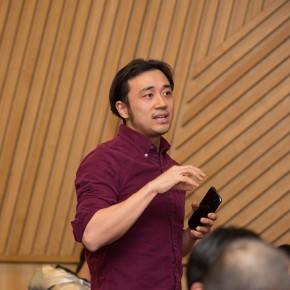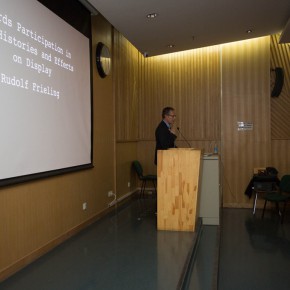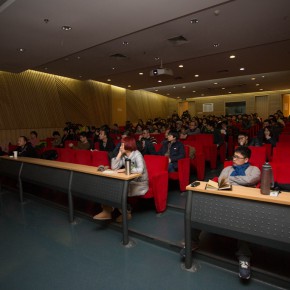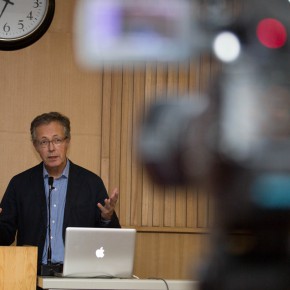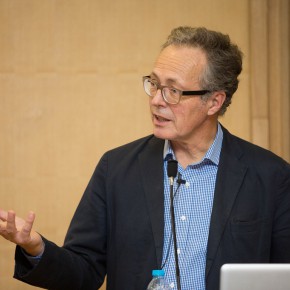
At 6:30 pm on December 16, 2015, the lecture “Towards Participation in Art: History and the Effects on Display” by Rudolf Frieling was held at the red chair lecture hall in CAFA. It was as one of the Leonardo art, science and technology series of lectures 2015, and it was hosted by the teacher Wang Yuyang from the Department of Experimental Art, CAFA. Rudolf Frieling is a professor from Hochschule für Grafik und Buchkunst Leipzig, former curator of the German ZKM, Host of the “Media Art Network” project, currently he is a curator for media art of the San Francisco Museum of Modern Art.
Since the 1960s, the radical and marginal practice of “participatory art” has been replaced by a mainstream international exhibition form. Emphasizing the relationship between the art museum and the public, implementing the interactive, communicating and social intervening “participatory art”, to continuously break and challenge the original artistic structure and the border of the art museum. In the lecture, taking the participatory art projects and the works by these artists as examples, Rudolf Frieling talked about and researched the background in development, evolution context, characteristics and the related problems of “participatory art”.
Media, Participation, Interaction: Expansion of the Border
Since 2006, with the emergence of a large number of social media tools, the public more and more look forward to participating in art. Rudolf Frieling pointed out that the most important thing now is to think of the relationship between art and the public and how to display the media art in the context of the art museum, rather than being confined by the media art center. At the same time, the development of science and technology offers a possibility for the development of media art and “participatory art”. At present, multimedia art has become an important form of art, and the artists often use media in order to help the masses involved it. But it should be pointed out that, bringing the “participatory art” into the art museum is not just a simple interaction and display of concept, but also blends the concept and interaction in multimedia art.
Meanwhile, the mechanism of the art museum and the artists’ concepts are also adjusted. On the one hand, the art museum actively display and collect multimedia art, with ongoing attempts in the level of guidance of the public to participate in it. On the other hand, the artists are not only satisfied with the control of the producing process, and hoping to participate in the re-display link after the work is collected. Rudolf Frieling stressed that, as a way to pursue democracy, the expansion of artistic participation was neither simply the political and democratic expression and feedback, nor the fake “participation” under the established planning project.
“Participatory Art”: Interpretation and Dialogue
In the “participatory art”, how to present, interpret and dialogue with the audience, how to help the audience actively and freely participate in art became the key problem. Then, Rudolf Frieling put forward 4 elements in “participatory art”: firstly, “participatory art” was not a single pattern, but rooted in the whole art creation and the structure of the art museum. Secondly, at present, there were many exhibitions, books and research articles about “participatory” art, such as the representative scholars Nicholas, Grant, Claire, etc. Thirdly, compared with the previous single discussion on contemporary art, the boundary of “participatory art” was constantly deriving and extending. Fourthly, the art museum offered a condition for the practice of “participatory art”.
After the analysis of the present situation, Rudolf Frieling talked about several early participatory artworks. Among them, Bruce Conner, Looking Glass, 1964, coll. SFMOMA: the work of the artist Bruce Conner was collected by the art museum that refused the artist permission to modify the work again. For this phenomenon, Rudolf Frieling said the art museum accepted the creative concept of the artist but refused his participating in the work again, while this acceptance and rejection was actually contradictory.
In addition, Rudolf Frieling also introduced Nam June Paik’s work “Television Crown”, in which the audience could through adjusting the switches of the X axis and Y axis control the effect on the screen, when the work was displayed at San Francisco Museum of Modern Art, the switches were replaced by two microphones. Rudolf Frieling said that the work could be regarded as the earlier artistic attempt in participatory art. In addition to the interactive work, Rudolf Frieling also talked about the problem of participatory in the performing art. He said that the performing art had a subjective form, and the rendering effect changed due to the different time, place and participants. The performing art was also with the help of the expressive style of media art, while the boundary between the performing art and performance art was blurred and mutually fused at the same time.
“Participatory Art”: Reproduction and Diversified Display
“Participatory Art” has a variety of rendering and participating ways, involved in interactive installation, performance, performing art, conceptual art, etc. Rudolf Frieling talked about the exhibition “Participation in Art: From 1950 to Now” that he planned at San Francisco Museum of Modern Art in 2009, the exhibition tried to research the developmental context of participatory art and discussed the second presentation of the specific artwork.
Regarding the diversified rendering forms of the “participatory art”, Rudolf Frieling listed several pieces, such as: Erwin Wurm, One Minute Sculptures, Since 1997; Ant Farm, Media Van, 1971; Lynn Hershman Leeson: The Agent Ruby Files; Jochen Gerz, The Gift/San Francisco, 2000/2008, etc. Rudolf Frieling said that, it was not hard to see that the artists tried to guide the audience to participate in these works, whether on-site participation or the participation of the internet mode, as well as the workshop mode, they all tried to make art more closely linked with the public, and the works finally presented an effect and participation that was impossible to presuppose, which was also the unique charm of “participatory art”.
At the end of the lecture, Rudolf Frieling was questioned by the audience on the differences between the “participatory art” and “interactive art”, as well as the transformation of concept of the art museum.
Text by Yu Ya, Photo by Yang Yanyuan/CAFA ART INFO
Translated by Chen Peihua and edited by Sue/CAFA ART INFO





